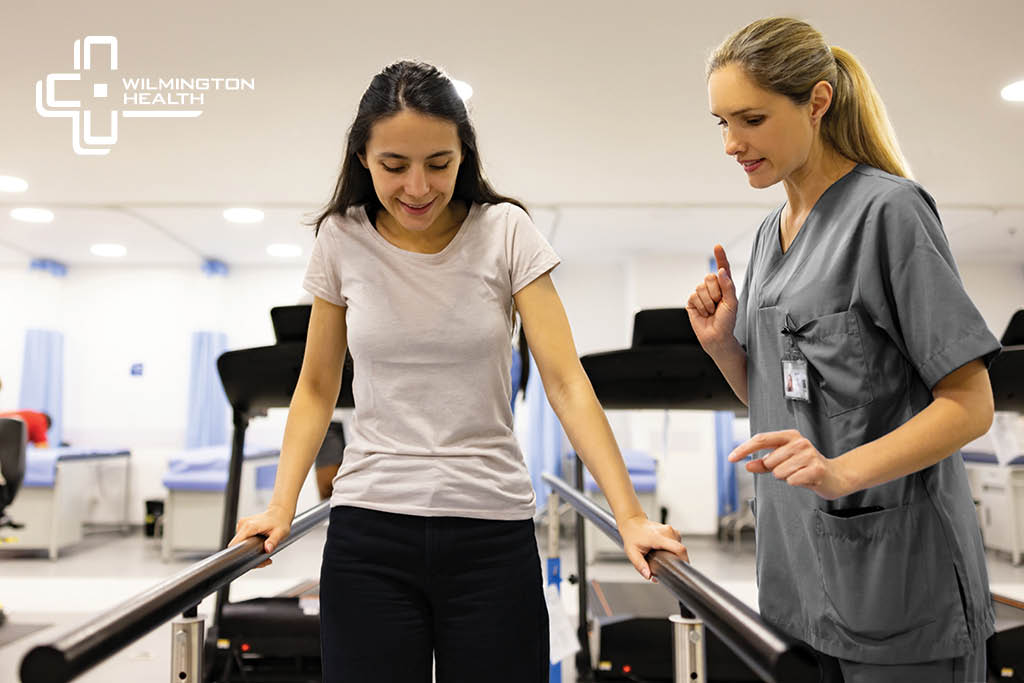It’s National Physical Therapy Month, so it’s the perfect time to talk more in depth about this method of care. Physical therapy is care that aims to ease pain and help you function, move and live better. It can also be used as a preventive measure against some injuries and disabilities.
The licensed physical therapists at Wilmington Health work closely with physicians and local
orthopedic surgeons to provide a comprehensive approach to all patients who require
physical therapy care. Wilmington Health clinicians provide physical therapy care in a one-on-one
treatment environment with a dedicated focus on injury prevention, rehabilitation, and education.
Wilmington Health’s licensed therapists treat adolescent to geriatric patients with various conditions from
gait and balance issues, to muscle strains, back pain, and athletic injuries — along with post-surgical
rehab patients. The state-of-the-art clinic provides rehabilitation tools to help with ambulation,
strength, endurance, balance, and daily living.
Treatment will include therapeutic exercise and a home exercise program and may also include
manual therapy and modalities to help with recovery speeds. But the primary goal is to get patients
back to living their best, pain-free life.
Another form of Physical therapy is pelvic floor therapy, which is a treatment that supports the patient
in improving the strength and function of the pelvic floor muscles. The overall objective is to
alleviate any pain and improve any weakness or dysfunction in the muscles. Below is a list of
services provided with pelvic floor therapy:
- Bladder training
- Biofeedback
- Manual therapy/massage
- Pelvic floor strengthening
- Prenatal/postpartum care
Rehabilitation Is Really Important
Whether it’s a knee, neck, or back injury, rehab is crucial in regaining strength, mobility, and
function. Although licensed physical therapists can work with patients to help them rehab, it’s important
for patients to take ownership of the rehabilitation process and work diligently on their own. A specific
protocol or plan will typically be assigned to the patient based on his or her rehabilitation needs.
Outpatient Physical Therapy
Outpatient rehabilitation will consist of various exercises designed to help regain range of
motion and build strength in the injured area. Sometimes an advanced strengthening program and
stationary cycle and walking program will be used to help increase range of motion and stamina,
and an aquatic therapy program may be added as well, depending on the injury.
Rehab At Home
Physical therapists will give patients a list of exercises and other activities to do at home for their
specific injury. Here are some examples of at-home rehabilitation guideline:
- Sitting: Use a chair with arms to help you rise to a standing position. Avoid sitting for longer than an hour if possible. If you must sit for a longer time, elevate the foot to avoid swelling.
- Walking: Do not put weight through the joint until you’ve been cleared to do so by your surgeon.
- Lifting: Do not lift more than 10 pounds.
- Showering: Showering is preferable to bathing in a tub because of difficulties getting in and out of the tub.
- Exercising: Do the exercises that were recommended by your doctor and physical therapist. Go to physical therapy as prescribed and get advice from your therapist as to whether you’re doing the exercises correctly.
- Getting into a car and driving: Get into a car by sitting on the edge of the seat, then pulling in the legs and turning to face forward. Driving is usually not recommended for the first six weeks post-op. Talk with your surgeon about driving sooner.
Along with physical therapy, Wilmington Health also offers orthopedic surgery as an option for more severe injuries. Orthopedics is a branch of medicine focused on preventing, treating, and correcting any deformities, disorders of, and injuries to the musculoskeletal system, which includes the bones, joints, muscles, tendons, ligaments, and nerves.
But the best way to deal with a musculoskeletal injury is to prevent it from happening. You can do several things everyday to continue living a healthy, pain-free life — like staying active in the office by doing preventive stretches and exercises without leaving the desk.
Learn more about Wilmington Health and its physical therapy programs at www.wilmingtonhealth.com/specialties/physical-therapy

